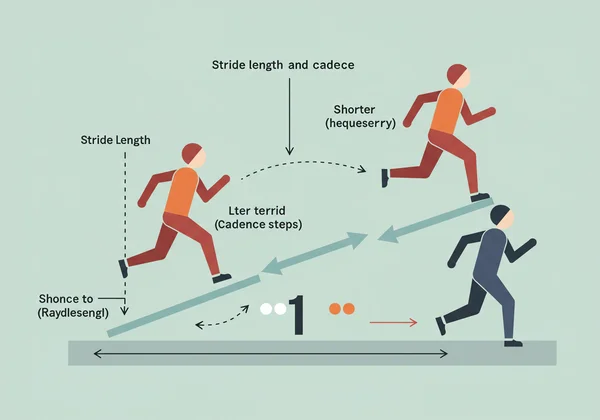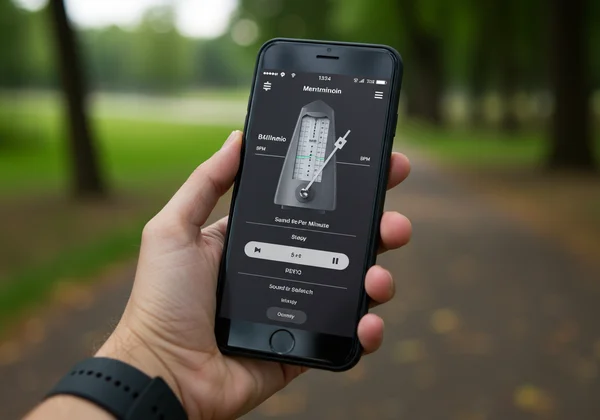المترونوم عبر الإنترنت للجري: تعزيز السرعة والإيقاع
هل أنت عداء تسعى باستمرار لتحسين أدائك، أو منع الإصابات، أو ببساطة العثور على إيقاع أكثر اتساقًا؟ يركز العديد من الرياضيين على المسافة والسرعة، لكنهم يتجاهلون مكونًا حاسمًا: الإيقاع. اكتشف كيف يمكن لأداة غالبًا ما يتم التقليل من شأنها - المترونوم عبر الإنترنت - أن تكون سلاحك السري لإتقان سرعة الجري والإيقاع. هل يمكن للمترونوم تحسين تقنية الجري لدي حقًا؟ بالتأكيد، وهذا الدليل سيُظهر لك كيف تحول جرياتك من فوضوية إلى متزامنة تمامًا.
يمكن للإيقاع الصحيح أن يحول الجري المرهق إلى تدفق سلس. إنه يوفر إشارة خارجية يرغب جسمك بشكل طبيعي في اتباعها، مما يؤدي إلى تحسين الكفاءة وتقليل خطر تجاوز خطوة. سواء كنت مبتدئًا تبني أساسًا أو عداء ماراثون مخضرم يسعى لتحقيق أفضل رقم شخصي جديد، فإن دمج المترونوم هو استراتيجية تغير قواعد اللعبة. هل أنت مستعد للعثور على إيقاعك المثالي؟ لنبدأ باستخدام مترونوم مجاني عبر الإنترنت وإطلاق العنان لإمكانياتك الحقيقية.

كيف يساعد المترونوم عبر الإنترنت في الجري
الجري، في جوهره، يدور حول الإيقاع. كل خطوة هي نبضة في أغنية الجري الشخصية الخاصة بك. عندما تكون هذه النبضات غير متسقة، يتأثر أسلوبك، وتُهدر طاقتك، ويتقلب سرعتك. يوفر استخدام إشارة صوتية بسيطة من المترونوم الهيكل الذي يحتاجه جسمك للأداء الأمثل، محولًا الأهداف المجردة مثل "الجري بشكل أسرع" إلى إجراء ملموس وقابل للقياس: "مطابقة الإيقاع". هذا هو المكان الذي يصبح فيه مترونوم للجري شريك تدريب لا يقدر بثمن.
فهم إيقاع الجري: السرعة مقابل الإيقاع
قبل أن نتعمق في التمارين، من الضروري فهم مصطلحين غالبًا ما يتم استخدامهما بالتبادل ولكنهما يعنيان أشياء مختلفة: وتيرة الجري والإيقاع.
- وتيرة الجري (Pace): هي مدى سرعتك في الجري، وعادة ما تقاس بالدقائق لكل ميل أو كيلومتر. إنها تخبرك بالوقت الذي تستغرقه لتغطية مسافة معينة. على سبيل المثال، وتيرة ميل في 9 دقائق.
- الإيقاع (Cadence): هو عدد الخطوات التي تتخذها في الدقيقة (SPM). إنه مقياس لسرعة دورانك أو تردد خطوتك. يشير الإيقاع الأعلى عمومًا إلى خطوات أقصر وأسرع.
بينما هما مرتبطان، إلا أنهما مقاييس مميزة. يمكنك أن يكون لديك نفس السرعة بإيقاعات مختلفة. ومع ذلك، فإن تحسين إيقاعك هو أحد أكثر الطرق فعالية لتحسين سرعتك وكفاءة الجري بشكل عام.
لماذا تعتبر الإشارات الإيقاعية الخارجية مهمة للعدائين
دماغك مُهيأ بالفطرة للتزامن مع الإيقاعات الخارجية. هذا هو السبب في أنك تطرق بقدمك بشكل غريزي مع الموسيقى. بالنسبة للعدائين، يعمل الإيقاع المسموع من المترونوم كمتتبع سرعة موضوعي وغير متزعزع. يساعدك هذا التغذية الراجعة السمعية على تجاوز التناقضات الداخلية الناتجة عن الإرهاق أو نقص التركيز.
أظهرت الدراسات أن الجري على إيقاع يمكن أن يقلل من الجهد المتصور للجري، ويحسن اقتصاد الأكسجين، ويشجع على ميكانيكا حيوية أفضل. من خلال التركيز على مطابقة خطواتك مع سرعة BPM للجري محددة، من غير المرجح أن تتجاوز خطوتك - وهو سبب شائع للإصابات مثل التهاب قصبة الساق والتهاب الركبة. يوفر المترونوم الانضباط للحفاظ على دوران متسق، حتى عندما يبدأ عقلك في الشرود.
إتقان إيقاع الجري لديك باستخدام المترونوم
يعد تحسين معدل خطوات الجري لديك أحد أسرع الطرق لرؤية تحسن كبير في أسلوبك وأدائك. يرتبط الإيقاع الأعلى بانخفاض قوة التأثير على مفاصلك، ووقت اتصال أقصر بالأرض، ومشية جري أكثر كفاءة. إليكم كيفية استخدام المترونوم لتحسينه بشكل منهجي.
العثور على إيقاعك الحالي: خطوة الأساس
لا يمكنك تحسين ما لا تقيسه. الخطوة الأولى هي تحديد إيقاع الجري الطبيعي الحالي لديك. إنها عملية بسيطة:
- اذهب للجري في مسار مستوٍ ومألوف بوتيرتك المعتادة.
- بمجرد أن تسخن وتستقر في إيقاعك، ابدأ مؤقتًا لمدة 60 ثانية.
- احسب عدد مرات ملامسة قدمك اليمنى للأرض في تلك الـ 60 ثانية.
- اضرب هذا الرقم في اثنين للحصول على إجمالي خطواتك في الدقيقة (SPM).
على سبيل المثال، إذا ضربت قدمك اليمنى الأرض 80 مرة في 60 ثانية، فإن إيقاعك هو 160 SPM. هذا الرقم هو خط الأساس الخاص بك. يمكنك بسهولة العثور على إيقاعك عن طريق الجري في المكان والنقر على ميزة تحديد الإيقاع بالنقر في أداتنا بما يتناسب مع إيقاع خطواتك.

تحديد هدف الإيقاع لديك: ما هو المثالي لك؟
قد تكون قد سمعت عن "الرقم السحري" وهو 180 SPM، والذي رَوَّج له مدرب الجري الشهير جاك دانيالز. في حين أن 180 SPM هو معيار رائع للعدائين النخبة، إلا أنه ليس هدفًا يناسب الجميع. النهج الأكثر فعالية هو السعي لزيادة تدريجية بنسبة 5-10٪ من خط الأساس الخاص بك.
لذلك، إذا كان إيقاعك الحالي هو 160 SPM، فإن زيادة بنسبة 5٪ ستكون 168 SPM. هذه قفزة صغيرة وقابلة للإدارة كافية لإحداث فرق ميكانيكي حيوي دون الشعور بعدم الارتياح أو الطبيعية. الهدف هو العثور على نقطتك المثالية لـ خطوات في الدقيقة، وليس فرض رقم تعسفي.
تمارين خطوة بخطوة لزيادة إيقاعك تدريجيًا
بمجرد حصولك على خط الأساس وهدفك، حان وقت التطبيق. لا تحاول الحفاظ على إيقاعك الجديد المستهدف طوال فترة الجري في البداية. بدلاً من ذلك، قم بدمج تمارين خطوة بخطوة:
- ضبط أداتك: افتح المترونوم المجاني على هاتفك. اضبط إيقاعك المستهدف (BPM) (مثل 168 BPM).
- ابدأ صغيرًا: ابدأ جريتك كالمعتاد. بعد الإحماء، قم بتشغيل المترونوم والجري لمدة 2-3 دقائق، مع التركيز فقط على مطابقة خطواتك مع الإيقاع. سيقوم عقلك بالعمل - فقط دع قدميك تهبط متزامنة مع "الصوت".
- الراحة والتكرار: قم بإيقاف تشغيل المترونوم والجري لمدة 5 دقائق بإيقاعك الطبيعي.
- دمج الفترات: كرر هذه الدورة 3-4 مرات أثناء الجري. قم بزيادة مدة فترات المترونوم تدريجيًا كلما أصبحت أكثر راحة.
تحسين وتيرة الجري لديك لتحقيق الكفاءة
بينما يتعلق الإيقاع بالدوران، فإن وتيرة الجري تتعلق بالسرعة. كلاهما متشابك بعمق. يوفر الإيقاع الثابت الأساس لسرعة مستقرة، مما يساعدك على تجنب الوقوع في فخ البداية السريعة جدًا والتلاشي في النهاية. أداة BPM عبر الإنترنت مثالية لتثبيت سرعتك المطلوبة.
ربط الإيقاع بالسرعة: علاقة تكافلية
كيف تزيد زيادة وتيرة الخطوات من سرعتك؟ سرعة الجري هي معادلة بسيطة: طول الخطوة × معدل الخطوة (الإيقاع). للجري بشكل أسرع، يمكنك إما اتخاذ خطوات أطول أو اتخاذ المزيد من الخطوات.
تجاوز الخطوة (اتخاذ خطوات أطول من الطبيعي) غير فعال وهو سبب رئيسي للإصابة. لذلك، فإن الطريقة الأكثر أمانًا وكفاءة لزيادة سرعتك هي زيادة إيقاعك مع الحفاظ على طول خطوة مماثل. يدربك المترونوم على اتخاذ خطوات أسرع وأخف، مما يدفعك بشكل طبيعي إلى الأمام بشكل أسرع دون جهد إضافي. يمكنك تجربة أداة BPM الخاصة بنا لتجربة إيقاعات مختلفة.

استخدام BPM للحفاظ على وتيرة جري ثابتة
أحد أكبر التحديات أمام عدائي المسافات الطويلة هو الحفاظ على سرعة ثابتة. من السهل أن تنخفض وتيرتك مع ظهور الإرهاق. يعمل المترونوم كمتتبع سرعة شخصي وغير قابل للتفاوض.
اضبط BPM على الإيقاع الذي يتوافق مع وتيرة عتبة اللاكتات لديك. أثناء الجري، وظيفتك الوحيدة هي الحفاظ على تزامن خطواتك مع الإيقاع. تمنع هذه الإشارة الخارجية التباطؤ اللاواعي وتساعدك على تحديد الجهد الدقيق المطلوب لسرعة هدفك. إنها أداة فعالة بشكل مدهش لتتبع السرعة في يوم السباق أو أي تمرين إيقاع منظم.
إعدادات المترونوم لتمارين الجري المختلفة (فترات، جري طويل)
المترونوم ليس فقط للجري السهل. إنها أداة تدريب متعددة الاستخدامات يمكن تكييفها مع أي تمرين.
- لتمارين الفترات: استخدم إعدادات BPM مختلفة. اضبط BPM أعلى لفتراتك السريعة لتشجيع دوران سريع، وBPM أقل لجريات الاسترداد لضمان حصولك على الراحة المناسبة.
- لجريات الإيقاع: اضبط المترونوم على الإيقاع الذي يتوافق مع وتيرة عتبة اللاكتات لديك. سيساعدك هذا على الالتزام بذلك الجهد "الصعب المريح" والحفاظ عليه.
- للجريات الطويلة: اضبط BPM ثابتًا ومستدامًا للمساعدة في الحفاظ على طاقتك والحفاظ على أسلوب متسق من الميل الأول إلى الأخير. هذا هو المفتاح لـ
منع الإصاباتعلى مدى الأميال الكثيرة.
البدء باستخدام المترونوم عبر الإنترنت للجري
هل أنت مستعد لتجربته؟ تم تصميم المترونوم المجاني عبر الإنترنت والمتوفر في المتصفح للبساطة والدقة، مما يجعله الرفيق المثالي للجري. لا يتطلب أي تنزيل أو تثبيت.

دليل إعداد سريع لأول جري لك مع المترونوم
- زيارة الصفحة الرئيسية: افتح متصفح هاتفك وانتقل إلى Metronome.wiki.
- ضبط BPM: استخدم شريط التمرير أو أزرار +/- لإدخال إيقاعك المستهدف (مثل 168 BPM).
- اختيار صوت: اختر صوتًا واضحًا ومسموعًا مثل "Woodblock" أو "Cowbell" الذي سيخترق أي ضوضاء محيطة.
- اضغط ابدأ وانطلق: ضع هاتفك في حامل ذراع أو جيب، وقم بتوصيل سماعات الرأس، وابدأ الجري. الأمر بهذه السهولة!
نصائح لدمج المترونوم في روتينك
لتحقيق أقصى استفادة من تدريب المترونوم، اتبع هذه أفضل الممارسات:
- كن صبورًا: قد تشعر بعدم الارتياح في البداية. امنح جسمك بضع جولات للتكيف مع الإيقاع الجديد.
- لا تستخدمه في جميع جولات الجري: استخدم المترونوم في 1-2 جري رئيسي في الأسبوع. لا تزال بحاجة إلى جولات "حرة" لاستيعاب الشعور.
- ركز على الأسلوب، وليس فقط على الخطوات: أثناء مطابقة الإيقاع، فكر في الجري بشكل مستقيم مع ميل طفيف إلى الأمام وهبوط قدميك تحت مركز كتلتك.
هل أنت مستعد للجري بإيقاع؟
الطريق لتصبح عداءً أفضل وأكثر كفاءة يقوم على الاتساق، ولا شيء يبني الاتساق مثل الإيقاع. المترونوم عبر الإنترنت هو أكثر من مجرد أداة للموسيقيين؛ إنه شريك تدريب قوي لأي رياضي يتطلع إلى إتقان إيقاعه وسرعته. من خلال توفير تغذية راجعة واضحة وموضوعية، فإنه يساعدك على بناء اتصال أقوى بين العقل والجسم وإطلاق مستوى جديد من الأداء.
الآن، حان وقت تطبيق ما تعلمته والانطلاق إلى الرصيف بإيقاع جديد.
هل أنت مستعد للعثور على إيقاعك المثالي؟ توجه إلى Metronome.wiki، واضبط أول BPM مستهدف لك، واشعر بالفرق في جريتك التالية. شارك أهداف إيقاع الجري الخاصة بك في التعليقات أدناه!
الأسئلة الشائعة حول المترونومات للجري
ما هو معدل الدقات في الدقيقة (BPM) المناسب للجري للمبتدئين؟
معدل الدقات في الدقيقة (BPM) المناسب للجري للمبتدئين هو عادة حوالي 160-170 SPM. ومع ذلك، فإن أفضل نهج هو أولاً قياس إيقاعك الطبيعي والسعي لزيادته بنسبة 5٪. تجنب القيام بقفزات كبيرة، حيث قد يكون ذلك غير طبيعي ويجهد عضلاتك. الهدف هو التحسن التدريجي والمستدام.
كيف أبدأ في استخدام مترونوم عبر الإنترنت للجري؟
البدء بسيط. أولاً، احسب إيقاعك الأساسي عن طريق حساب خطواتك لمدة دقيقة واحدة. ثم، قم بزيارة موقعنا، واضبط BPM على رقم أعلى بنسبة 5٪ من خط الأساس الخاص بك، واختر صوتًا واضحًا، واضغط على ابدأ، وحاول مطابقة خطواتك مع الإيقاع لفترات قصيرة أثناء الجري. تم تصميم المترونوم الخاص بنا عبر الإنترنت ليكون بديهيًا للاستخدام المباشر.
هل يمكن للمترونوم عبر الإنترنت تحسين أسلوب الجري لدي حقًا؟
نعم، بالتأكيد. الفائدة الأساسية لـ الجري مع المترونوم هي أنه يثبط تجاوز الخطوة - أن تهبط قدمك أمام مركز ثقل جسمك بكثير. من خلال تشجيع دوران أسرع، فإنه يساعدك بشكل طبيعي على هبوط قدميك بالقرب من مركز جاذبيتك، مما يقلل من قوى الكبح ويقلل من التأثير على مفاصلك، مما يؤدي إلى أسلوب أفضل بشكل عام.
كم مرة يجب أن أتدرب باستخدام مترونوم الجري؟
لست بحاجة إلى استخدامه في كل جري. استراتيجية جيدة هي دمجه في واحد أو اثنين من التمارين الرئيسية في الأسبوع. على سبيل المثال، استخدمه أثناء جري سهل في منتصف الأسبوع للتركيز فقط على الأسلوب والإيقاع، أو أثناء جري إيقاعي للمساعدة في تثبيت سرعة هدفك. هذا يمنح جسمك وقتًا لترسيخ الإيقاع الجديد في جرياتك الأخرى.